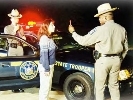
Drunken Driving Down, But Drugged Driving Raises Alarms
NHTSA's first roadside survey to test for drugs as well as alcohol found 16.3 percent of nighttime weekend drivers were drug positive, most commonly from marijuana, cocaine, and OTC or prescription drugs.
The National Highway Traffic Safety Administration's 2007 roadside survey used new screening techniques to test for drug impairment, and here's what was found: 16.3 percent of nighttime weekend drivers were drug positive, while 2.2 percent registered a blood alcohol concentration of .08 or higher, which is the legal limit in all U.S. states and the District of Columbia. NHTSA announced this on Monday and said among the drivers who were drug positive, this most commonly resulted from marijuana (8.6 percent), cocaine (3.9 percent), and over-the-counter and prescription drugs (3.9 percent).
As you'd expect, federal officials saw the data as good news and bad news alike. In 1973, 7.5 percent of drivers had a blood alcohol concentration of .08 or higher, so that prevalence has dropped significantly.
"I'm pleased to see that our battle against drunk driving is succeeding," said U.S. Transportation Secretary Ray LaHood said. "However, alcohol still kills 13,000 people a year on our roads, and we must continue to be vigilant in our efforts to prevent drunk driving."
"This troubling data shows us, for the first time, the scope of drugged driving in America and reinforces the need to reduce drug abuse," said Gil Kerlikowske, director of the Office of National Drug Control Policy. "Drugged driving, like drunk driving, is a matter of public safety and health. It puts us all at risk and must be prevented."
Mothers Against Drunk Driving issued a statement saying the 71 percent decrease in the percentage of drunken drivers at nighttime checkpoints since 1973 is gratifying. "Law enforcement leadership deserves credit for this remarkable progress," said Laura Dean-Mooney, MADD's national president. "To a disturbing extent, this survey confirms that we are a nation of drug users, both legal and illegal."
The NHTSA report points out that drug traces stay in the body much longer than alcohol, so a driver who had traces of drugs in the survey might have used the drug days or weeks before being stopped. "This gives the illusion that drugs are being used more often than alcohol. This isn't the case," MADD said in its statement. "In fact, if alcohol traces stayed in the body for the same period as drugs, the survey would have found that the percentage of recent alcohol use by drivers would approach 60 percent. Other research findings make clear that the drug to really worry about on the highway continues to be alcohol, since much of the other drug use is done in combination with alcohol. The bottom line is that no one has the right to put others at risk by driving impaired."